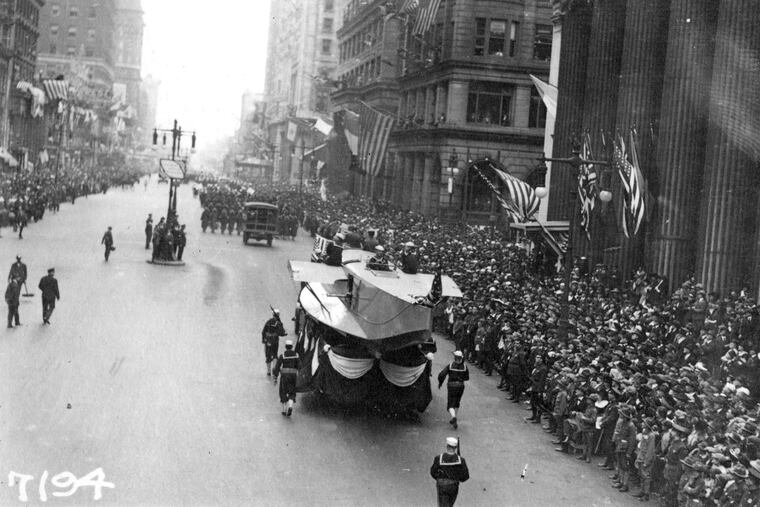In 1918, it was Spanish influenza that afflicted Philadelphia sports
During that fall and winter, the flu killed an estimated 50 million worldwide, 675,000 in the United States.

The cartoon on The Inquirer sports front on Oct. 6, 1918 portrayed what was happening in Philadelphia during the grim grip of the Spanish influenza that fall and winter.
A disheveled, cigar-chomping fan was pictured sitting atop a sporting world that had been “closed on account of illness.”
“Gee,” the disgruntled fan said, “this is gittin’ to be a lonesome dump.”
In 2020, as sports officials here and elsewhere struggle to deal with the worldwide coronavirus outbreak, the influenza epidemic of a century ago might offer some clues.
During that fall and winter, the flu killed an estimated 50 million worldwide, 675,000 in the United States. Here in Philadelphia, where at one point city workers went block to block collecting bodies, 12,191 residents died in a four-week period. More than 700 succumbed on Oct. 16 alone.
» READ MORE: Ivy League cancels basketball conference tournaments; Yale men, Princeton women get NCAA bids
All throughout the city, little girls were chanting a macabre rhyme as they jumped rope:
Officials responded by banning most public gatherings. Impacted sporting events included high school and college football games, amateur soccer matches, and a fight between Jack Dempsey and Battling Levinsky.
The outbreak also claimed some prominent Philadelphia sports figures.
A former Penn football star, tackle William Robinson, died from the illness while training to be an Army pilot. Chandler Richter, the son of the founder and editor of the Sporting Life, an influential, Philadelphia-based weekly, was another casualty. And the brother of A’s manager Connie Mack, Tom, died from the flu at his Massachusetts home with his famous brother at his side.
“My dad was delirious,” Tom’s daughter Helen told reporters. “But when Uncle Connie came, he straightened up and they talked about family and business and baseball. They spent the last few hours together before my father died. Uncle Connie was very shaken.”
At Penn, where the Quakers were coming off a Rose Bowl appearance in 1917, the flu hit football hard. Coach Bob Folwell had to be hospitalized, and at one point in mid-October, only 22 of his players were healthy enough to practice.
Penn’s game against Georgia Tech was canceled. The Quakers postponed a contest with the Navy Yard’s Marines, and when it took place on Oct. 26, it was played at an empty Franklin Field.
A campus rally for a much-anticipated game against eventual national champion Pitt was called off, as was a war-bond fund-raiser featuring movie star William S. Hart.
» READ MORE: Phillies adjusting to new reality of living amid coronavirus fear, as MLB ponders next steps
Penn wasn’t alone. Most college football teams, including an unbeaten Michigan squad, had to shorten their schedules because of the epidemic.
While Pittsburgh allowed them to take place in empty stadiums, Philadelphia banned all high school football games. When Minneapolis did the same, some schools ignored the restriction and police had to stop the illicit contests.
Major League Baseball got lucky. Because of World War I, its season had ended a month early, on Sept. 2, before the worst of the outbreak. Still, throughout organized baseball, at least seven players, including Negro League star Ted Kimbro, eventually died from the flu.
In Philadelphia, that early conclusion to the season spared the sixth-place Phillies and eighth-place Athletics any real effect. But by the time the Red Sox and Cubs met in the only World Series played entirely in September, the flu was gaining strength.
That Series was contested despite the pleadings of some Boston physicians, who warned that the big crowds at Fenway Park could be disease incubators. Boston’s Babe Ruth, then a robust 23-year-old, was stricken twice but fought it off sufficiently to pitch and win a pair of games for the victorious Red Sox.
Baseball would temporarily ban the spitball as a health precaution, and in at least one minor-league game, players wore masks, prodded by a little ditty that urged them to “obey the laws and wear the gauze. Protect your jaws from septic paws.”
» READ MORE: Penn’s AJ Brodeur: Ivy League canceling basketball tournament ‘doesn’t feel right’ | Mike Jensen
The nontitle fight between Dempsey and Levinsky, a Philadelphia light heavyweight, was postponed in late September. When it finally took place in November at the Olympia Club, Dempsey scored a third-round knockout.
Philadelphia wouldn’t have an NHL team for another 49 years, but the impact of the flu on the hockey league can be detected on its most famous artifact, the Stanley Cup.
Amid the roster of champions engraved on the Cup is this entry:
The Canadiens had gone to overtime to win Game 5 in Seattle on March 30. Afterward, several Montreal players collapsed with fevers as high as 105. Some had to be hospitalized. Others were helped back to their hotels.
With the series tied at 2-2-1, the deciding game was set to be played on April 1. Less than six hours before its scheduled start, Montreal general manager George Kennedy, himself ill, said his flu-depleted team was unable to continue. When the NHL rejected his request to use players from another team, Kennedy announced that the Cup would have to be forfeited to Seattle.
The sporting Metropolitans wouldn't accept his largesse, contending that the illness was not the Canadiens' fault and that they should not be made to suffer because of it.
Four days later, one of the afflicted Canadiens, defenseman Joe Hall, died. Kennedy never fully recovered and succumbed a few years later.